Visual Search and Information Processing Speed
Added on 2023-06-11
46 Pages13333 Words304 Views
[Author Name(s), First M. Last, Omit Titles and Degrees]
[Institutional Affiliation(s)]
[Institutional Affiliation(s)]

CHAPTER FOUR
INFLUENCE OF SUBCLINICAL ANXIETY LEVELS ON INFORMATION
PROCESSING SPEED AND INTRA-INDIVIDUAL VARIABILITY IN YOUNGER AND
OLDER ADULTS
Introduction
The main aim of this chapter revolves around examination of the potential impacts of non-
clinical levels of anxiety, depression, subjective memory function and objective cognitive
function, as well as educational level and gender, with regard to information processing speed
that is related to attention in both the young and old adults through the use of commonly adopted
visual search task (Tales, Bayer, Haworth et al, 2010). Visual search task has found its
application on several occasions in the past in the measurement of the potential differences that
exist between information processing speed and attentional shifting using visual attention
processes that are related to information processing speed in the MCI, AD and healthy aging
(Craik, 2012).
Contrary to the way it has been done by other researchers in their previous studies (Landy et al,
2015; Kiss et al, 2012; Tales et al, 2010; Madden , Gottlob et al, 1999), the research that makes a
significant aspect of this PhD evaluates these aspects of processing of information in both the
young and older adults as well as evaluating into details the possible impacts upon such findings
of factors that are either not sufficiently addressed or completely not addressed in the previous
studies and research (Craik, 2012), (i.e. non-clinical anxiety, subjective memory function, sex
and education). This search topic also aims at finding out how the factor that might have been
INFLUENCE OF SUBCLINICAL ANXIETY LEVELS ON INFORMATION
PROCESSING SPEED AND INTRA-INDIVIDUAL VARIABILITY IN YOUNGER AND
OLDER ADULTS
Introduction
The main aim of this chapter revolves around examination of the potential impacts of non-
clinical levels of anxiety, depression, subjective memory function and objective cognitive
function, as well as educational level and gender, with regard to information processing speed
that is related to attention in both the young and old adults through the use of commonly adopted
visual search task (Tales, Bayer, Haworth et al, 2010). Visual search task has found its
application on several occasions in the past in the measurement of the potential differences that
exist between information processing speed and attentional shifting using visual attention
processes that are related to information processing speed in the MCI, AD and healthy aging
(Craik, 2012).
Contrary to the way it has been done by other researchers in their previous studies (Landy et al,
2015; Kiss et al, 2012; Tales et al, 2010; Madden , Gottlob et al, 1999), the research that makes a
significant aspect of this PhD evaluates these aspects of processing of information in both the
young and older adults as well as evaluating into details the possible impacts upon such findings
of factors that are either not sufficiently addressed or completely not addressed in the previous
studies and research (Craik, 2012), (i.e. non-clinical anxiety, subjective memory function, sex
and education). This search topic also aims at finding out how the factor that might have been
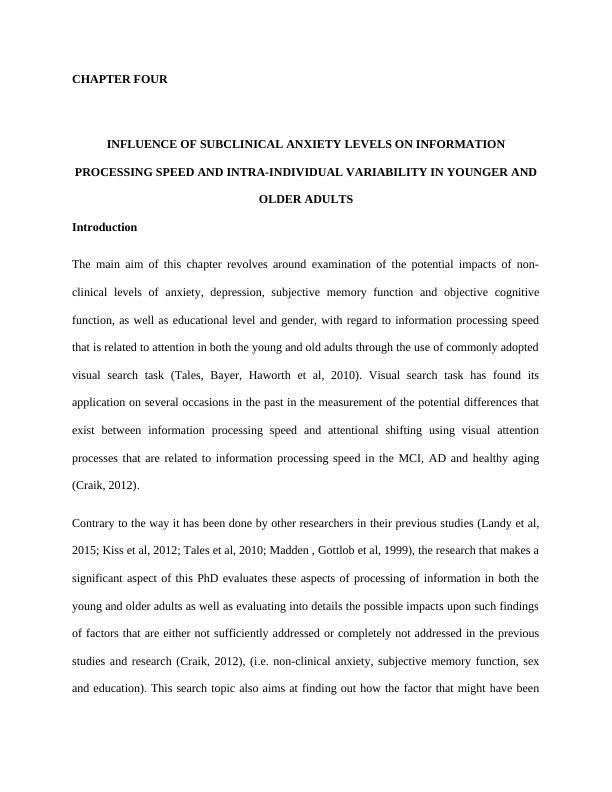
ignored in the previous studies could affect the speed of processing information and their
influence on the future. An interpretation of the visual search test results are interpreted with
focus given to that which encompasses an ostensibly cognitively health older adult control group
while performing studies on function that are related to visual attention and the speed if
processing information in dementia and MCI.
Cognitive aging is typically defined on the basis of a general decrease in the levels of cognitive
performance especially a general decline in the processing speed based on the mean performance
of an individual (Kapur, 2015). In the most recent past, it has been noticed that there is a rise in
intra-individual variability (IIV), with an increase in age categorically in older adults Bunce, D.
et al. (2013). The neuroimaging research that has been going on about aging has conventionally
given a lot of attention on the trends of the mean groups including mean cognitive decline with
age. To date, there are still very few studies that exist as afar as variability is concerned. This
leads to very little knowledge available regarding neural underpinnings of RT and IIV. As
mentioned in the previous chapters, the current study is focused on establishing and examining
the age differences in information processing speed and its variability in relationship with non-
clinical anxiety levels (in particular), subjective memory function, objective cognitive function
and other related factors such as sex and years of education as well as depression that have not
investigated before, by using the visual search take.
Numerous approaches are used in the description of the variability of the behavior of an
individual. These ways of behavioral individual variability can be summed up into four: Short-
term, also called trail to trail within the variability of the task or inconsistency Luck, S. J., &
Vogel, E. K. (2013) - This way illustrates the rapid and transient fluctuations that take place over
short scales of time for example within a task that os performed in barely 10 minutes.
influence on the future. An interpretation of the visual search test results are interpreted with
focus given to that which encompasses an ostensibly cognitively health older adult control group
while performing studies on function that are related to visual attention and the speed if
processing information in dementia and MCI.
Cognitive aging is typically defined on the basis of a general decrease in the levels of cognitive
performance especially a general decline in the processing speed based on the mean performance
of an individual (Kapur, 2015). In the most recent past, it has been noticed that there is a rise in
intra-individual variability (IIV), with an increase in age categorically in older adults Bunce, D.
et al. (2013). The neuroimaging research that has been going on about aging has conventionally
given a lot of attention on the trends of the mean groups including mean cognitive decline with
age. To date, there are still very few studies that exist as afar as variability is concerned. This
leads to very little knowledge available regarding neural underpinnings of RT and IIV. As
mentioned in the previous chapters, the current study is focused on establishing and examining
the age differences in information processing speed and its variability in relationship with non-
clinical anxiety levels (in particular), subjective memory function, objective cognitive function
and other related factors such as sex and years of education as well as depression that have not
investigated before, by using the visual search take.
Numerous approaches are used in the description of the variability of the behavior of an
individual. These ways of behavioral individual variability can be summed up into four: Short-
term, also called trail to trail within the variability of the task or inconsistency Luck, S. J., &
Vogel, E. K. (2013) - This way illustrates the rapid and transient fluctuations that take place over
short scales of time for example within a task that os performed in barely 10 minutes.
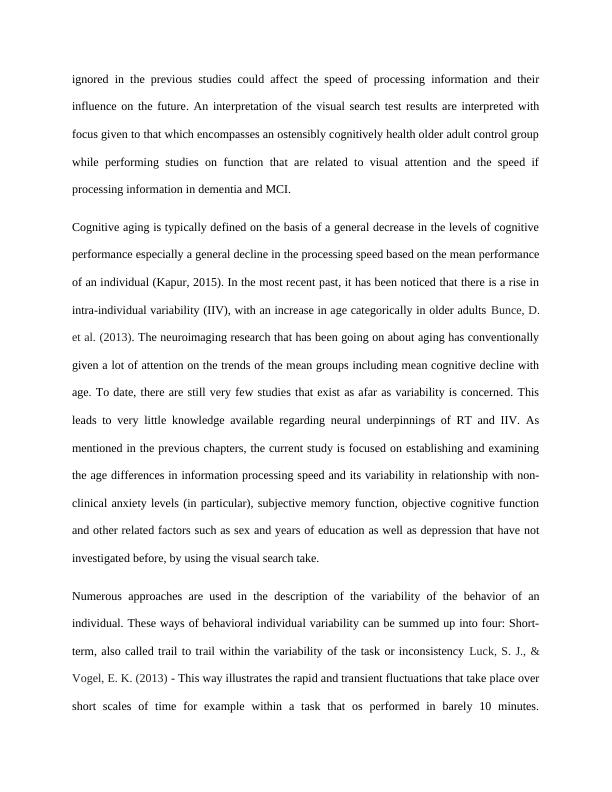
Intraindividual variability throughout tasks, also called dispersion. Alterations that are relatively
permanent and gradually evolve over comparatively long time scales for example over months or
year through developments or training- This way of behavioral individual change is defined as
intraindividual change. Intraindividual variability or a variability between individual and is also
defined as diversity (Schmorrow, 2009). These changes are of essence to the study as they can be
used as predicate of the personal traits of an individual and this can be used as the basis for
grouping of people into either healthy or people with cognitive memory impairment.
A study, cognitive intraindividual variability and white matter integrity in aging (Smith, 2014),
was done that focused on inconsistency that is also defined as variability within a short task or
short term. In the paper, inconsistency was referred to as IIV. Cognitive intraindividual
variability and white matter integrity in aging studies have noticed that inconsistency tends to
increase with an increasing in age as individual approaches adulthood (Smith, 2014). Such
studies are also supportive of the fact inconsistency is a stable and meaningful illustrator of the
difference between individuals. Most cognitive intraindividual variability and white matter
integrity in aging studies have adopted and used the paradigms of reaction time (RT) and have
noticed that as the age increases, there is a significant increase in the individual standard
deviations. This is so even after controlling has been done for the response time base rate.
The findings painted a less clear picture with reference to the accuracy based scores. This is due
to the fact that there are just but a few studies on the one hand and the failure of numerous
authors to notice an increase in IIV with age through the utilization of the accuracy scores on the
other hand. Other studies have also demonstrated a U-shaper curve that occurs across the
lifespan in relation to IIV as young and older adults illustrate a large inconsistency levels. In
addition, in as much as inconsistency is often associated with possibility of dysfunction, it is
permanent and gradually evolve over comparatively long time scales for example over months or
year through developments or training- This way of behavioral individual change is defined as
intraindividual change. Intraindividual variability or a variability between individual and is also
defined as diversity (Schmorrow, 2009). These changes are of essence to the study as they can be
used as predicate of the personal traits of an individual and this can be used as the basis for
grouping of people into either healthy or people with cognitive memory impairment.
A study, cognitive intraindividual variability and white matter integrity in aging (Smith, 2014),
was done that focused on inconsistency that is also defined as variability within a short task or
short term. In the paper, inconsistency was referred to as IIV. Cognitive intraindividual
variability and white matter integrity in aging studies have noticed that inconsistency tends to
increase with an increasing in age as individual approaches adulthood (Smith, 2014). Such
studies are also supportive of the fact inconsistency is a stable and meaningful illustrator of the
difference between individuals. Most cognitive intraindividual variability and white matter
integrity in aging studies have adopted and used the paradigms of reaction time (RT) and have
noticed that as the age increases, there is a significant increase in the individual standard
deviations. This is so even after controlling has been done for the response time base rate.
The findings painted a less clear picture with reference to the accuracy based scores. This is due
to the fact that there are just but a few studies on the one hand and the failure of numerous
authors to notice an increase in IIV with age through the utilization of the accuracy scores on the
other hand. Other studies have also demonstrated a U-shaper curve that occurs across the
lifespan in relation to IIV as young and older adults illustrate a large inconsistency levels. In
addition, in as much as inconsistency is often associated with possibility of dysfunction, it is
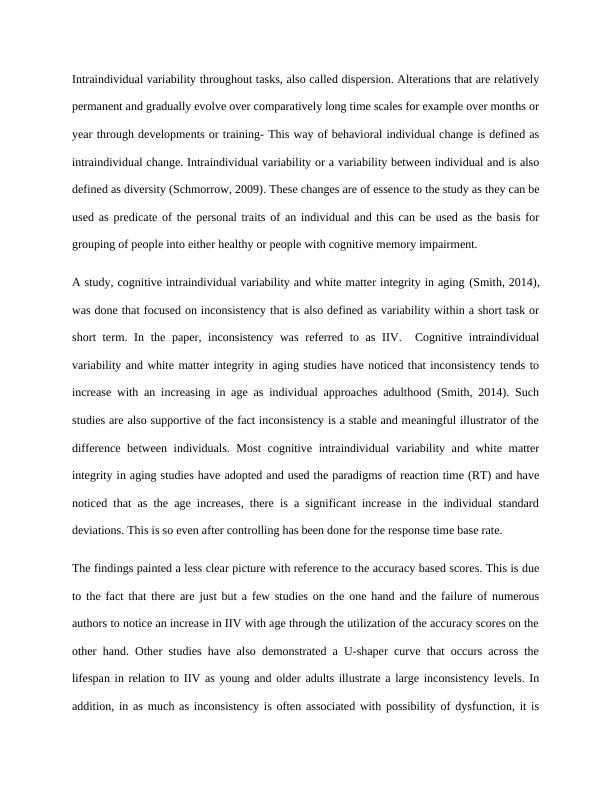
arguable that it is one of the pieces of evidence of an adaptive dynamic process (Gonçalves-
Pereira, 2016).
Despite the tremendous growth in studies have been witnessed over the past, not so much
knowledge on information processing speed and inconsistency in aging are available as well as
there is very little research to show on its neural underpinning. As Hultsch et al. once mentioned,
in relation to the corpus work which is based on the mean performance level, the quantity and
quality of information that has been brought forth by research imaging and cognition is
miniscule. More specifically, it is not any clear whether or not there are the same bases for mean
performance and IIV. Hultsch et al. observes that despite the available information still in very
rare unity, the available research findings have been able to illustrate a link between IIV and the
characteristics of the human brain through the use of either functional or structural brining
imaging (Q. Ashton Acton, 2012).
Bunce and colleagues were able to illustrate that there was an association between the hyper
intensities of the white matter in the frontal cortex and the larger IIV within a response time task.
Their finding was not with performance tasks that are perceived to be more complex (Craik,
2012). Other findings reported that there is a correlation between the volume of white matter and
IIV in response time, RTs. The very findings also established that response times are more
correlated with the volume of the cortical grey matter, GM. Through a comparison that was
made between the influence of white matter and grey matter on IIV in both the young and old
adults, the scholar found out that only the white matter had an influence and impact on the
increase of behavioral inconsistences that is related to age. Of all the parameters of DTI, it was
found out that only fractional anisotropy, FA was linked to the cognitive variability upon the
control of age as a factor Zhang, R et al. (2018).
Pereira, 2016).
Despite the tremendous growth in studies have been witnessed over the past, not so much
knowledge on information processing speed and inconsistency in aging are available as well as
there is very little research to show on its neural underpinning. As Hultsch et al. once mentioned,
in relation to the corpus work which is based on the mean performance level, the quantity and
quality of information that has been brought forth by research imaging and cognition is
miniscule. More specifically, it is not any clear whether or not there are the same bases for mean
performance and IIV. Hultsch et al. observes that despite the available information still in very
rare unity, the available research findings have been able to illustrate a link between IIV and the
characteristics of the human brain through the use of either functional or structural brining
imaging (Q. Ashton Acton, 2012).
Bunce and colleagues were able to illustrate that there was an association between the hyper
intensities of the white matter in the frontal cortex and the larger IIV within a response time task.
Their finding was not with performance tasks that are perceived to be more complex (Craik,
2012). Other findings reported that there is a correlation between the volume of white matter and
IIV in response time, RTs. The very findings also established that response times are more
correlated with the volume of the cortical grey matter, GM. Through a comparison that was
made between the influence of white matter and grey matter on IIV in both the young and old
adults, the scholar found out that only the white matter had an influence and impact on the
increase of behavioral inconsistences that is related to age. Of all the parameters of DTI, it was
found out that only fractional anisotropy, FA was linked to the cognitive variability upon the
control of age as a factor Zhang, R et al. (2018).
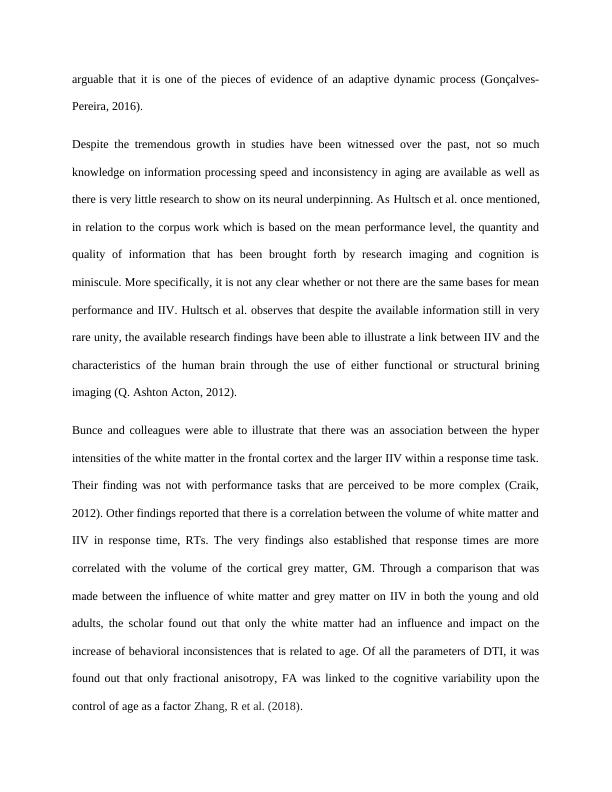
On the contrary, a control for the mean performance as was observed by another research
established significant relationship and correlations between all the parameters of DTI and the
inconsistency in a great sample of healthy individuals. Suggestions were also made that cognitive
variability which is having a higher correlation with these parameters than the median
performance would prove to be a better correlate o the variations in the structure of the white
matter; as the strength of such correlations were observed to increase in the older adults
(Goswami, 2015).
Theoretical and practical link between delay in cognition and the pace of information processing
is a measurement that is commonly applied in the research process as an indicator of human
behavior. Studies provide considerable evidences in support of inter-relationship between
cognition, information processing speed, behavior and white and grey matter integrity adopted
through aging (Akimoto et al., 2014). Slowing of information processing speeds as one grows
older is connected to structural changes, which conceptually affect the general brain functions,
perceptions of functional integrity and cognition gradually (Akimoto et al., 2014). Younger
adults are generally exceptionally active in comparison with older adults, as their general brain
functioning is still active and observing normal performance in structural aspects (Bryant et al.,
2008). In other words, probabilities of MCI, Alzheimer and slow information processing speed
are far less in young individuals, in comparison with their older counterparts (Tales et al., 2010).
Based on that, RT measures need to consider many aspects of typical behavior and
environmental interaction (Rodrigues & Pandeirada, 2014; Tales & Basoudan, 2016). Results of
information processing speed tests in clinical populations may need to be interpreted with respect
to such caveats, making it difficult to relate clinical findings to research findings. It is included in
DSM-5 for measurement, specifically with respect to attention-related processing (Naveteur
established significant relationship and correlations between all the parameters of DTI and the
inconsistency in a great sample of healthy individuals. Suggestions were also made that cognitive
variability which is having a higher correlation with these parameters than the median
performance would prove to be a better correlate o the variations in the structure of the white
matter; as the strength of such correlations were observed to increase in the older adults
(Goswami, 2015).
Theoretical and practical link between delay in cognition and the pace of information processing
is a measurement that is commonly applied in the research process as an indicator of human
behavior. Studies provide considerable evidences in support of inter-relationship between
cognition, information processing speed, behavior and white and grey matter integrity adopted
through aging (Akimoto et al., 2014). Slowing of information processing speeds as one grows
older is connected to structural changes, which conceptually affect the general brain functions,
perceptions of functional integrity and cognition gradually (Akimoto et al., 2014). Younger
adults are generally exceptionally active in comparison with older adults, as their general brain
functioning is still active and observing normal performance in structural aspects (Bryant et al.,
2008). In other words, probabilities of MCI, Alzheimer and slow information processing speed
are far less in young individuals, in comparison with their older counterparts (Tales et al., 2010).
Based on that, RT measures need to consider many aspects of typical behavior and
environmental interaction (Rodrigues & Pandeirada, 2014; Tales & Basoudan, 2016). Results of
information processing speed tests in clinical populations may need to be interpreted with respect
to such caveats, making it difficult to relate clinical findings to research findings. It is included in
DSM-5 for measurement, specifically with respect to attention-related processing (Naveteur

et.al. 2005). Research indicates that information processing speed can vary significantly with
respect to methodological factors such as the task used and thus areas of the brain recruited for
performance and response demands and person-related factors such as sex and educational level
(Tales, Bayer, Haworth & Snowden, 2010). Such research evidence indicates that the results of
information processing speed tests in clinical populations may need to be interpreted with respect
to such caveats, especially as there is a high degree of variability in the tasks used to measure
information processing speeds in clinical populations, making the comparison of results within
the clinical arena problematic and also making it difficult to relate clinical findings to research
findings. Information processing speed that is related to ageing has either failed to successfully
address sex as one of the factors influencing the relation or made a concrete comparison between
the impacts of sex on the speed of information processing same as with the case of years of
educatio (John, 2012)n. Furthermore, DSM 5 that elaborates on the need of measuring the speed
of information processing does not provide any elaborations on the impacts of sex and years of
education and the possible effects on the results generated by RT studies.
It is possible that other factors that are rarely researched and rarely tested in clinical conditions,
may also affect information processing speed. One such factor is anxiety. Salthouse (2011)
highlighted the possibility that anxiety may affect RT performance and that although high levels
of clinical anxiety may be acknowledged to affect information processing speeds, lower levels of
anxiety are generally not considered to have any effect. In contrast, however, Tales and
Basoudan (2016) noted that anxiety has a high prevalence in older adults and that even non-
clinical anxiety may impact cognitive performance. One aim of this research is to determine the
potential of sub-clinical anxiety to affect the outcome of information processing speed in older
adults, as well as in younger adults.
respect to methodological factors such as the task used and thus areas of the brain recruited for
performance and response demands and person-related factors such as sex and educational level
(Tales, Bayer, Haworth & Snowden, 2010). Such research evidence indicates that the results of
information processing speed tests in clinical populations may need to be interpreted with respect
to such caveats, especially as there is a high degree of variability in the tasks used to measure
information processing speeds in clinical populations, making the comparison of results within
the clinical arena problematic and also making it difficult to relate clinical findings to research
findings. Information processing speed that is related to ageing has either failed to successfully
address sex as one of the factors influencing the relation or made a concrete comparison between
the impacts of sex on the speed of information processing same as with the case of years of
educatio (John, 2012)n. Furthermore, DSM 5 that elaborates on the need of measuring the speed
of information processing does not provide any elaborations on the impacts of sex and years of
education and the possible effects on the results generated by RT studies.
It is possible that other factors that are rarely researched and rarely tested in clinical conditions,
may also affect information processing speed. One such factor is anxiety. Salthouse (2011)
highlighted the possibility that anxiety may affect RT performance and that although high levels
of clinical anxiety may be acknowledged to affect information processing speeds, lower levels of
anxiety are generally not considered to have any effect. In contrast, however, Tales and
Basoudan (2016) noted that anxiety has a high prevalence in older adults and that even non-
clinical anxiety may impact cognitive performance. One aim of this research is to determine the
potential of sub-clinical anxiety to affect the outcome of information processing speed in older
adults, as well as in younger adults.
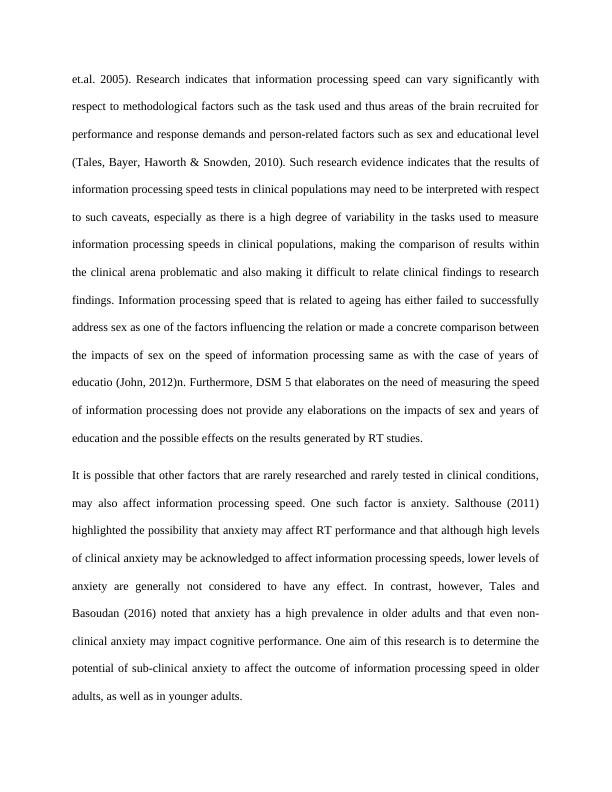
Another factor that has rarely been considered in the investigation of information processing
speed in ageing and ageing-related disease is subjective cognitive function. There has been
growing concerns about cognitive decline specifically in memory mostly in older adults and it is
increasing becoming evident that both dementia and MCI could be characterized by an earlier
stage which is normally termed as subjective cognitive impairment. It should be noted however
that complaints of subjective cognitive are not always representative of a prodromal stage of
dementia with some of the causes such as sleep disorder, anxiety and anxiety being potentially
responsive. Regardless of the casualty there have been concerns on the negative impacts that
memory function can have on the everyday life as well as the mental health Donaghy, P. C.,
O'brien, J. T., & Thomas, A. J. (2015).
SCI are associated with neuropsychological test performance that is objectively defined (John,
2012). Chances are that objective change can be missing in functions including memory since
the test adopted are at times insensitive and hence cannot be used in ,measuring the specific
aspects of the memory of an individual. there can be detrimental changes that can occur in the
functions of the brain other than the fact that memory may take place in what is referred to SCI
even though this may be challenging to be described by the general public (Goswami, 2015).
Available evidence illustrates that there is significant disruption of the operations of the
fundamental brain in people with SCI. this makes it a possibility that the fundamental process of
the brain may lead to impairment of the function of the memory even though there has not been
any concrete evidence from the existing neuropsychological protocol of testing.
In as much as there is proof of existence of a relation between cognition, information processing
speed, integrity of white and grey matter and behavior especially in aging, dementia and MCI,
speed in ageing and ageing-related disease is subjective cognitive function. There has been
growing concerns about cognitive decline specifically in memory mostly in older adults and it is
increasing becoming evident that both dementia and MCI could be characterized by an earlier
stage which is normally termed as subjective cognitive impairment. It should be noted however
that complaints of subjective cognitive are not always representative of a prodromal stage of
dementia with some of the causes such as sleep disorder, anxiety and anxiety being potentially
responsive. Regardless of the casualty there have been concerns on the negative impacts that
memory function can have on the everyday life as well as the mental health Donaghy, P. C.,
O'brien, J. T., & Thomas, A. J. (2015).
SCI are associated with neuropsychological test performance that is objectively defined (John,
2012). Chances are that objective change can be missing in functions including memory since
the test adopted are at times insensitive and hence cannot be used in ,measuring the specific
aspects of the memory of an individual. there can be detrimental changes that can occur in the
functions of the brain other than the fact that memory may take place in what is referred to SCI
even though this may be challenging to be described by the general public (Goswami, 2015).
Available evidence illustrates that there is significant disruption of the operations of the
fundamental brain in people with SCI. this makes it a possibility that the fundamental process of
the brain may lead to impairment of the function of the memory even though there has not been
any concrete evidence from the existing neuropsychological protocol of testing.
In as much as there is proof of existence of a relation between cognition, information processing
speed, integrity of white and grey matter and behavior especially in aging, dementia and MCI,

End of preview
Want to access all the pages? Upload your documents or become a member.
Related Documents
Effects of Sub-clinical Anxiety Levelslg...
|39
|8262
|18
Anxiety influence Information Processing Speed Assignmentlg...
|32
|9062
|81
Effects of Anxiety on Different Aspects of Information Processinglg...
|34
|10399
|104
(PDF) Anxiety disorders in older adultslg...
|34
|9370
|58
Anxiety, Reaction Time, and the Variability of Reaction Time in Younger and Older Adultslg...
|91
|11426
|49
Difference in Non-Clinical Anxiety Levels between Young and Older Adults and in Respect to Depression, Cognitive Functions and Demographic Parameterslg...
|34
|10472
|446
